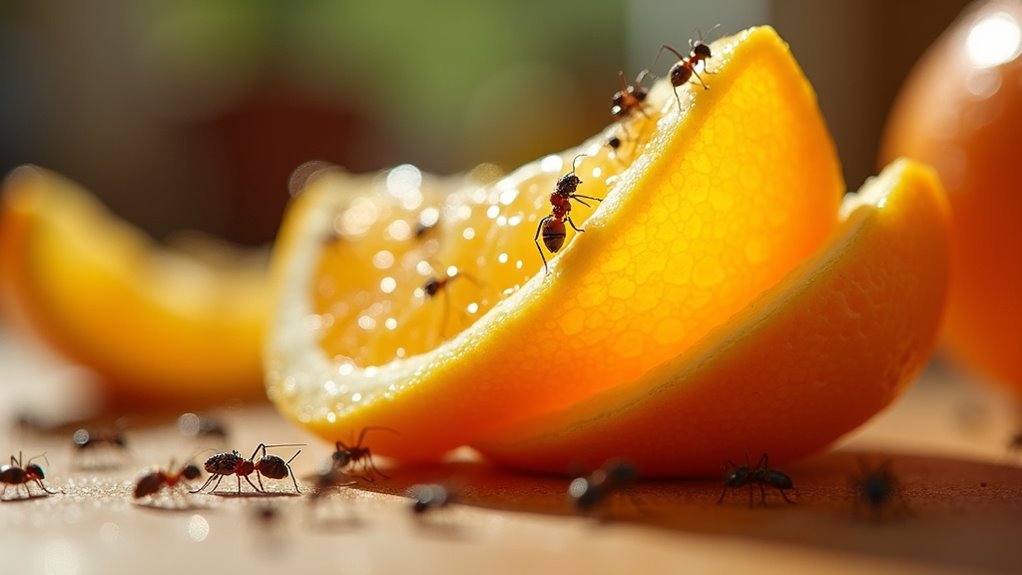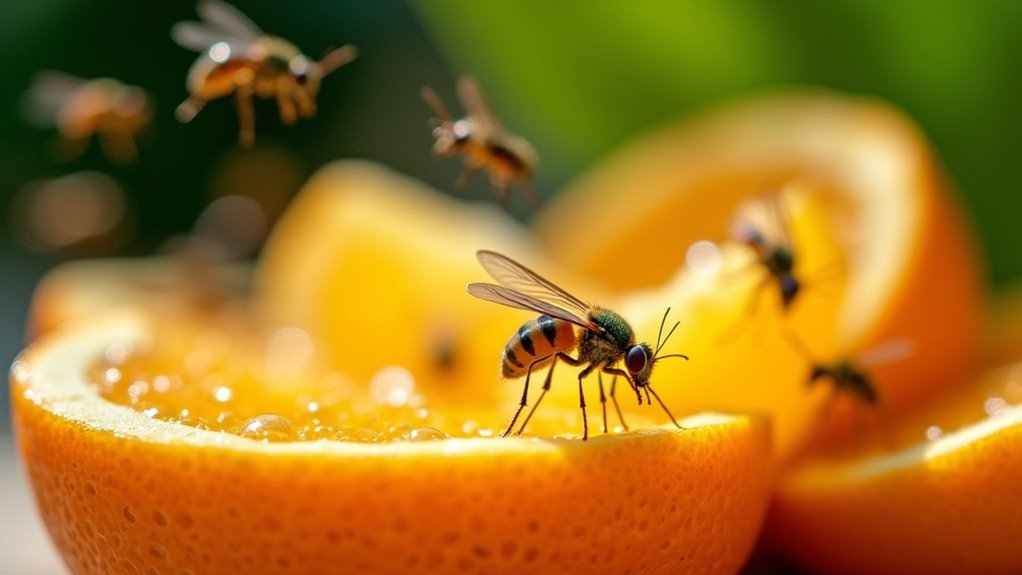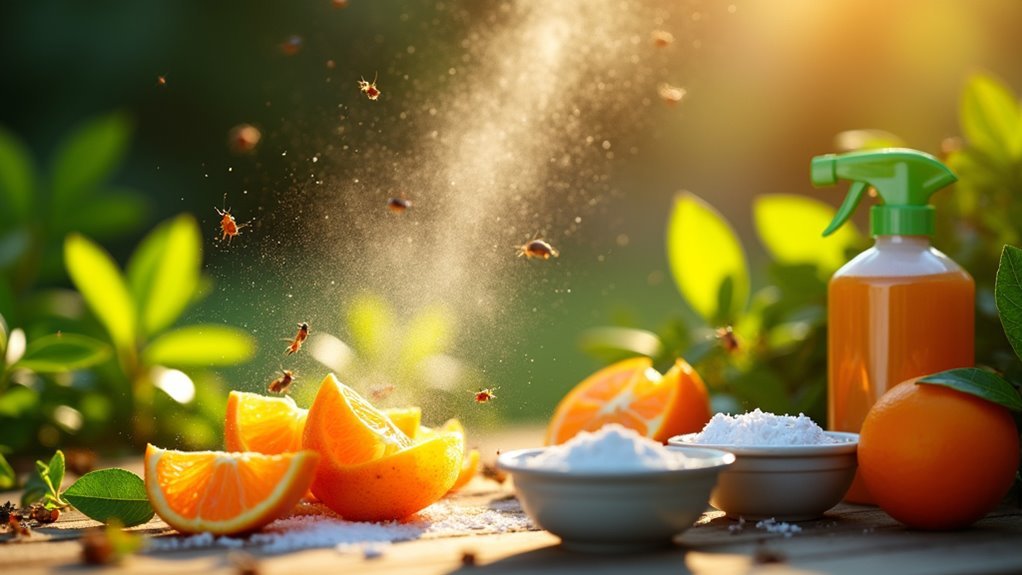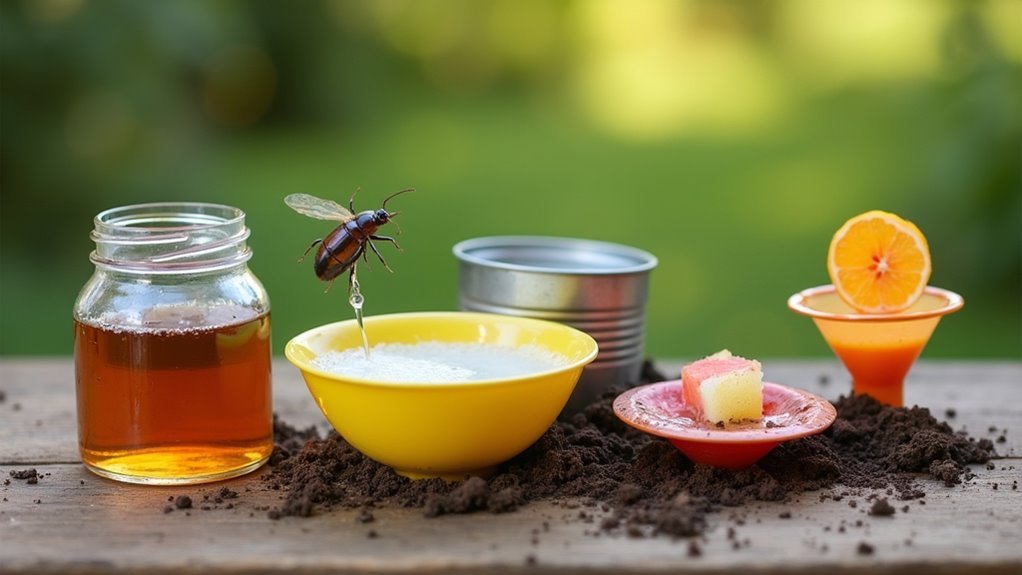You can create a powerful orange peel spray by soaking fresh peels in white vinegar for two weeks, then straining and transferring to a spray bottle. The D-Limonene in orange peels effectively repels ants, roaches, and fleas by disrupting their behavior patterns. This natural alternative is safer than chemical pesticides around children and pets. Apply to entry points and pest-prone areas, shaking before each use. Discover how adding simple ingredients amplifies this spray’s effectiveness.
Natural Citrus Oils That Repel Common Household Pests

While chemical pest control can be effective, natural citrus oils offer a safer and equally powerful alternative for keeping household pests at bay. You’ll find that D-Limonene, extracted from orange peels, works exceptionally well against ants, roaches, and fleas.
These natural citrus oils don’t just repel pests – they actively disrupt their behavior patterns, making your home less attractive to unwanted invaders.
Natural citrus oils disrupt pest behavior patterns, creating an unwelcoming environment that deters unwanted invaders from settling in your home.
When you’re dealing with Home Pest Control challenges, orange peel extracts provide antimicrobial properties that reduce harmful bacteria while deterring insects. You can safely apply these solutions around children and pets without worrying about toxic exposure.
The oils target common entry points like kitchens and doorways, where pests typically infiltrate your living space, creating an effective barrier that keeps bugs away naturally.
Essential Ingredients for Maximum Bug-Fighting Effectiveness
When you’re crafting an orange peel spray, you’ll want to harness D-Limonene’s powerful oil compounds that naturally repel insects on contact.
Adding baking soda to your mixture creates a desiccant effect that’ll dehydrate bugs while amplifying the citrus oils’ effectiveness.
For maximum potency, you can enhance your spray with diluted Pine Sol, which acts as a natural insecticide booster that transforms your basic orange peel solution into a thorough pest-fighting formula.
D-Limonene Orange Oil Power
The powerhouse behind orange peel spray’s bug-fighting capabilities lies in D-Limonene, a potent natural compound extracted from citrus peels that packs a serious punch against household pests. This remarkable ingredient doesn’t just repel insects—it’s a dual-action powerhouse with antimicrobial properties that’ll transform your pest control approach.
| D-Limonene Benefits | Effectiveness Details |
|---|---|
| Active Concentration | 5.8% in commercial sprays |
| Target Pests | Ants, roaches, fleas |
| Scent Appeal | Pleasant to humans, repellent to bugs |
| Duration | Longer-lasting than chemicals |
| Safety Profile | Gentle, non-toxic alternative |
When you’re mixing your homemade spray, combining D-Limonene with baking soda and Pine Sol creates an enhanced barrier. I’m using this new account to share that users consistently report superior results with multiple applications.
Baking Soda Desiccant Properties
Beyond D-Limonene’s impressive pest-fighting abilities, baking soda serves as your secret weapon through its powerful desiccant properties that literally dry out insects from the inside.
When you combine baking soda with orange peel extract, you’re creating a dual-action formula that attacks bugs on multiple fronts. The desiccant effect works exceptionally well against soft-bodied pests like gnats and cockroaches, which can’t survive significant moisture loss.
You’ll find that regular applications create an environment where insects simply can’t thrive. The baking soda doesn’t just repel—it eliminates by disrupting their natural ability to retain water.
This systematic dehydration process means you’re not just driving bugs away temporarily; you’re actually reducing their population over time through targeted elimination.
Pine Sol Natural Enhancement
Pine Sol amplifies your orange peel spray’s bug-fighting power by adding natural insecticidal properties that target household pests with remarkable efficiency.
The active ingredient works synergistically with orange peel’s natural oils, creating a potent mixture that repels ants, cockroaches, and gnats effectively.
- Dilution ratio: Mix 1 part Pine Sol concentrate with 4 parts water to prevent plant damage
- Target pests: Effectively repels ants, cockroaches, gnats, and other common household insects
- Enhanced potency: Active ingredients combine with citrus oils for greatest bug-fighting effectiveness
- Desiccant boost: Adding baking soda creates dual-action repelling and moisture-absorbing properties
- Application frequency: Regular use delivers improved long-term pest management results
You’ll achieve ideal results by maintaining consistent application schedules, as users report increased success with regular treatments over time.
Step-by-Step Guide to Creating Orange Peel Spray
Making your own orange peel spray requires just five simple steps that’ll transform kitchen scraps into an effective bug deterrent.
First, collect fresh orange peels and place them in a sealed mason jar. Fill the jar with white vinegar, ensuring peels are completely submerged beneath the liquid.
Start with fresh orange peels in a mason jar, then cover completely with white vinegar for proper infusion.
Second, let the mixture soak for two weeks in a cool, dark location. This allows natural citrus oils to infuse into the vinegar, creating a potent solution.
Third, strain out all orange peels after the two-week period ends. Transfer the infused vinegar into a clean spray bottle for convenient application.
Fourth, apply the spray to surfaces where pests gather or enter your home.
Finally, shake the bottle before each use to mix ingredients and maintain the citrus scent’s effectiveness.
Targeted Insects and Application Techniques

While orange peel spray works against various household pests, you’ll find it particularly effective against ants, roaches, fleas, and gnats. The natural oils in orange peels create a potent barrier that repels these insects effectively.
For best results, apply the spray strategically:
- Target entry points like doorways, windowsills, and cracks where pests enter
- Spray areas where you frequently spot insects gathering
- Vacuum visible pests before application to reduce population
- Guarantee thorough coating on surfaces for maximum deterrent effect
- Reapply regularly since natural sprays require consistent use
You can use orange peel spray both indoors and outdoors, making it versatile for different environments.
However, keep it away from pets and food areas. Remember that natural alternatives won’t provide instant results like chemical pesticides, so patience and regular reapplication are key.
Safety Considerations for Pets and Family Members
While orange peel spray is marketed as family-friendly, you’ll need to exercise caution around your pets since D-Limonene can be toxic if they ingest or inhale it.
You should apply the spray only in areas your pets can’t easily reach and keep them away from treated surfaces until they’re completely dry.
For children, the product is generally safe but can still irritate eyes and skin, so you’ll want to supervise application and store it securely.
Pet Toxicity Warnings
Though orange peel spray offers a natural solution for pest control, it poses significant risks to your furry family members. The active ingredient D-Limonene can be toxic to cats and dogs if they ingest or inhale it, making careful application critical.
You must take these precautions to protect your pets:
- Apply spray only in areas completely out of your pets’ reach
- Guarantee proper ventilation during and after application to prevent respiratory irritation
- Store the product in a secure, pet-inaccessible location
- Monitor your pets closely after use for any adverse reactions
- Contact your veterinarian immediately if symptoms develop
The pleasant orange scent that humans enjoy can overwhelm pets’ sensitive respiratory systems, potentially causing serious health complications requiring immediate veterinary attention.
Child Safe Application
Even natural ingredients like D-Limonene require careful handling around children, who are more sensitive to essential oils and prone to accidental exposure. You’ll want to apply the spray when kids aren’t nearby, guaranteeing they don’t return to treated areas until completely dry. The pleasant orange scent might attract curious children, so store the product in locked cabinets after use.
| Application Step | Child Safety Measure | Precaution Level |
|---|---|---|
| Before spraying | Remove children from area | High |
| During application | Guarantee good ventilation | Medium |
| After treatment | Wait for complete drying | High |
| Storage | Lock away from reach | Critical |
Test small areas first to monitor any unexpected reactions, and maintain proper ventilation since concentrated citrus scents can overwhelm sensitive individuals.
Boosting Results With Baking Soda and Pine Sol Additions

Although orange peel spray works well on its own, you’ll see dramatically better results when you combine it with baking soda and Pine Sol. This enhanced formula creates a potent natural bug repellent that leverages multiple pest-fighting mechanisms.
Here’s how to maximize your results:
- Mix 1 part Pine Sol concentrate with 4 parts water to prevent plant damage
- Add orange peels for their natural insect-repelling oils
- Include baking soda as a desiccant to dry out pest exoskeletons
- Apply regularly around entry points for cumulative effectiveness
- Use both indoors and outdoors for versatile pest control
Users consistently report success against cockroaches, ants, and gnats with this combination.
The Pine Sol’s insecticidal properties work alongside orange oils and baking soda’s moisture-absorbing action, creating a thorough barrier that keeps pests away from your home.
Storage Tips and Reapplication Schedule for Best Results
Three key storage practices will determine whether your orange peel spray maintains its bug-fighting power or loses effectiveness within days.
First, store your spray in a cool, dark place to preserve the natural oils and extend shelf life.
Second, shake the container well before each use since oils naturally separate over time.
Third, apply the spray only after cleaning treated areas to eliminate competing scents that attract pests.
You’ll need to reapply every 1-2 weeks for ideal pest control, particularly in high-activity zones.
Monitor treated areas regularly and increase application frequency if you notice pest activity resuming.
This consistent approach guarantees your homemade solution continues repelling bugs effectively rather than becoming a wasted effort.
Frequently Asked Questions
Do Orange Peels Keep Bugs Away?
Yes, you’ll find orange peels effectively repel bugs like ants and cockroaches. They contain D-Limonene oils that naturally deter pests. You can spray diluted orange peel mixtures around entry points for eco-friendly pest control.
Does Orange Peel Keep Flies Away?
Yes, orange peels effectively repel flies through D-Limonene oils that create a natural citrus barrier. You’ll see best results when you regularly apply orange peel solutions around entry points and kitchen areas.
How Long Does Bug Spray Stay Active?
You’ll find bug spray stays active for several days, but you should reapply every few days for best results. Weather conditions and humidity affect duration, so you’ll need more frequent applications during peak pest season.
Why Should You Put Orange Peels Around Your House?
You should place orange peels around your house because they naturally repel ants, roaches, and gnats through D-Limonene oils. They’re eco-friendly, safe for pets and children, and freshen your home.
In Summary
You’ve discovered a powerful, natural weapon against household pests with orange peel spray. You’re now equipped to create an effective bug repellent that’s safe for your family and pets. Don’t forget to store your spray properly and reapply regularly for maximum effectiveness. With consistent use and optional boosters like baking soda, you’ll keep unwanted insects at bay while avoiding harsh chemicals. Your home’s now protected naturally.





Leave a Reply